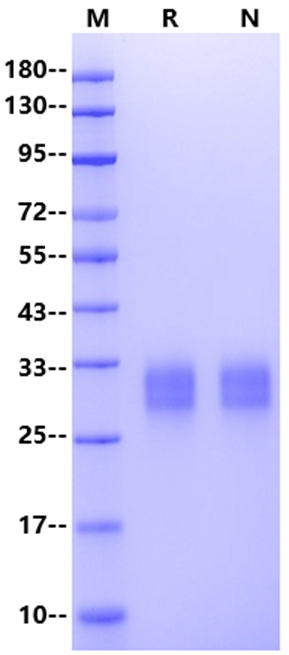Gln73-Met232, with N-terminal 8*His HHHHHHHHGGGSQQQGRLDKLTVTSQNLQLENLRMKLPKPPKPVSKMRMATPLLMQALPMGALPQGPMQNATKYGNMTEDHVMHLLQNADPLKVYPPLKGSFPENLRHLKNTMETIDWKVFESWMHHWLLFEMSRHSLEQKPTDAPPKESLELEDPSSGLGVTKQDLGPVPM
28-33kDa
PBS, pH7.4
Reconstitute at 0.1-1 mg/ml according to the size in ultrapure water after rapid centrifugation.
· 12 months from date of receipt, lyophilized powder stored at -20 to -80℃.
· 3 months, -20 to -80℃ under sterile conditions after reconstitution.
· 1 week, 2 to 8℃ under sterile conditions after reconstitution.
· Please avoid repeated freeze-thaw cycles.
1、Zola H. et al. (2007) CD molecules 2006-human cell differentiation molecules. J Immunol Methods. 318(1-2): 1-5.
2、Ho I C. et al. (2009) GATA3 and the T-cell lineage: essential functions before and after T-helper-2-cell differentiation. Nat Rev Immunol. 9(2): 125-135.
3、Matesanz-Isabel J. et al. (2011) New B-cell CD molecules. Immunology Letters. 134(2): 104-112.
CD74 (MHC class II invariant chain, Ii) is a non-polymorphic type II transmembrane glycoprotein. It was initially identified to act mainly as an MHC class II chaperone. However, it is clear that CD74 has a much wide range of biological functions in physiological and pathological situations in addition to its regulatory roles on cell surface MHC II expression. CD74 also participates in other non-MHC II protein trafficking. Importantly, CD74 molecule is a cell membrane high-affinity receptor for macrophage migration inhibitory factor (MIF), D-dopachrome tautomerase (D-DT/MIF-2), and bacterial proteins that also behave as an accessory signaling molecule, which undergoes regulated intramembrane proteolysis (RIP) upon its ligand binding.
